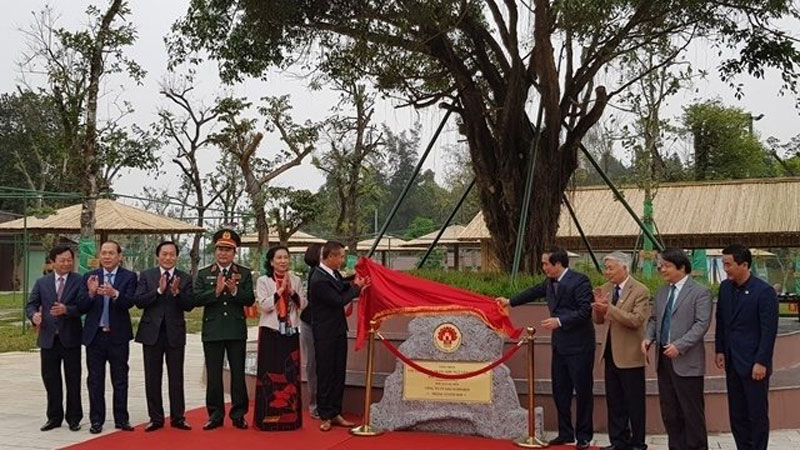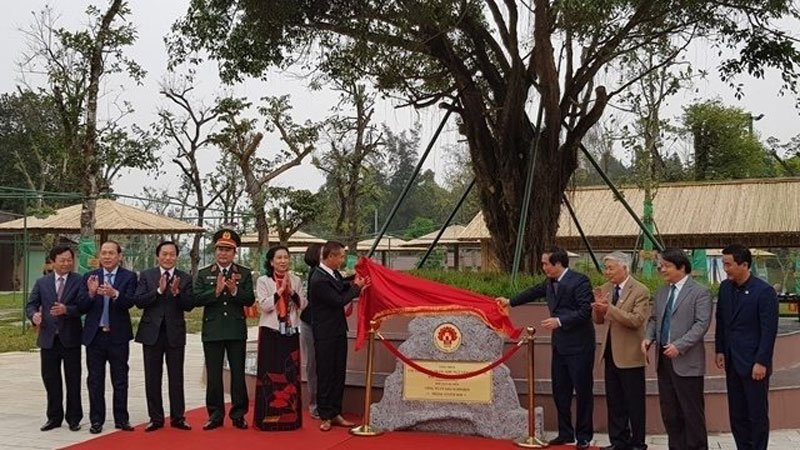
A project, aiming to upgrade the landscape and plant trees in the area of cross-road in Gieng Temple under the Special National Historical Relic Site of Hung Kings Temple in the northern province of Phu Tho, was inaugurated and put into use on December 15, after three months of construction.

At the ceremony.
The project was implemented by Asia Slipform Corporation,
with a VND 30billion investment, which came from private sources.
According to Director of the
Management Board of the Hung Kings Temple relic site, Nguyen Duy Anh, said the
project includes upgrading the system of roads, lighting and trees, and
building 50 booths with architecture suitable for the landscape of the area
Secretary of Phu Tho
Provincial Party Committee, Bui Minh Chau, said that the inauguration and
putting into use of the project before the Lunar New Year 2019 has a very
practical meaning. It will create the most favorable conditions for people
across the country when they visit the Hung Kings Temple during the Lunar New
Year and the Hung Kings Temple Festival 2019 and the following years,
contributing to preserving and promoting the values of the Hung Kings temple
relic site, he add.
The Hung Kings Temple is
located on Nghia Linh Mountain, Phong Chau district, in Phu Tho province, about
100km northwest of Hanoi. It is a complex of ancient tombs, monuments and
temples.
The annual festival to commemorate the Hung Kings,
which falls on the 10th day of the third lunar month, was first recognised as a
national event in 2007.
Source: NDO
With an increasingly vibrant and widespread emulation movement aimed at building cultured residential areas and cultured families, Yen Thuy District has been making steady progress toward improving both the material and spiritual well-being of its people, while fostering a civilized, prosperous, beautiful, and progressive community.
Once lacking recreational spaces and community facilities, Residential Group 2 in Quynh Lam Ward (Hoa Binh City) has recently received attention for the construction of a new, spacious, and fully equipped cultural house. The project followed the model of state support combined with public contributions in both labor and funding.
The "All people unite to build cultural life" movement, which has been effectively integrated with Kim Boi district’s socio-economic development goals, is fostering a lively spirit of emulation across local residential areas, hamlets, villages, public agencies, and enterprises. In addition, through the initiative, traditional cultural values are being preserved and promoted, while community solidarity and mutual support in poverty reduction and economic development are being strengthened.
A working delegation of the Hoa Binh provincial People’s Committee led by its Permanent Vice Chairman Nguyen Van Toan on June 11 inspected the progress of a project to build the Mo Muong Cultural Heritage Conservation Space linked to tourism services in Hop Phong commune, Cao Phong district.
Born and growing in the heroic land of Muong Dong, Dinh Thi Kieu Dung, a resident in Bo town of Kim Boi district, in her childhood was nurtured by the sweet lullabies of her grandmother and mother. These melodies deeply imprinted on her soul, becoming an inseparable part of her love for her ethnic group's culture. For over 20 years, this love for her hometown has driven Dung to research, collect, and pass down the cultural values of the Muong people to future generations.
In the final days of May, the Ethnic Art Troupe of Hoa Binh Province organized performances to serve the people in remote, mountainous, and particularly disadvantaged areas within the province. These were not just ordinary artistic shows, but they were the meaningful journeys aimed at spreading cultural values, enhancing the spiritual life of the people and contributing to the preservation of ethnic minority cultural identities.



